|
Sunday:
October 24, 2004 | |
1006 GMT |
 |
International Space Station crew returns to Earth
Leaving behind the International Space Station that served as their orbiting home for the past half-year, the Expedition 9 crew safely journeyed back to Earth on Saturday. Tucked inside the Russian Soyuz TMA-4 capsule, the crew landed in north-central Kazakhstan at 8:36 p.m. EDT (0036 GMT).
 FULL STORY FULL STORY
 MISSION STATUS CENTER - updates! MISSION STATUS CENTER - updates!
 EARLIER PREVIEW EARLIER PREVIEW
 |  |

|
 |

Additional coverage for subscribers:
 VIDEO:
SATURDAY'S EXPEDITION 9 FAREWELL CEREMONY QT VIDEO:
SATURDAY'S EXPEDITION 9 FAREWELL CEREMONY QT
 VIDEO:
THE THREE CREW MEMBERS BOARD SOYUZ CAPSULE QT VIDEO:
THE THREE CREW MEMBERS BOARD SOYUZ CAPSULE QT
 VIDEO:
SOYUZ CAPSULE UNDOCKS FROM THE SPACE STATION QT VIDEO:
SOYUZ CAPSULE UNDOCKS FROM THE SPACE STATION QT
 VIDEO:
STATION EXTERNAL CAMERAS SHOWS DEPARTING SOYUZ QT VIDEO:
STATION EXTERNAL CAMERAS SHOWS DEPARTING SOYUZ QT
 VIDEO:
CREW CONFIRMS IGNITION OF DEORBIT BURN QT VIDEO:
CREW CONFIRMS IGNITION OF DEORBIT BURN QT
 VIDEO:
THE RE-ENTRY PLASMA TRAIL SEEN FROM SPACE QT VIDEO:
THE RE-ENTRY PLASMA TRAIL SEEN FROM SPACE QT
 VIDEO:
SOYUZ TOUCHDOWN IN KAZAKHSTAN ANNOUNCED QT VIDEO:
SOYUZ TOUCHDOWN IN KAZAKHSTAN ANNOUNCED QT
 VIDEO:
RECOVERY FORCES OPEN THE SOYUZ HATCH QT VIDEO:
RECOVERY FORCES OPEN THE SOYUZ HATCH QT
 VIDEO:
COMMANDER PADALKA PULLED FROM CAPSULE QT VIDEO:
COMMANDER PADALKA PULLED FROM CAPSULE QT
 VIDEO:
FINCKE SPEAKS ABOUT SPACEFLIGHT AFTER CAPSULE EXIT QT VIDEO:
FINCKE SPEAKS ABOUT SPACEFLIGHT AFTER CAPSULE EXIT QT

 VIDEO:
PREVIEW OF LANDING AND RECOVERY PROCESS QT VIDEO:
PREVIEW OF LANDING AND RECOVERY PROCESS QT
 VIDEO:
FRIDAY'S CHANGE-OF-COMMAND CEREMONY QT VIDEO:
FRIDAY'S CHANGE-OF-COMMAND CEREMONY QT
 VIDEO:
RECAP OF EXPEDITION 9 MISSION QT VIDEO:
RECAP OF EXPEDITION 9 MISSION QT
 VIDEO:
OVERVIEW OF EXPEDITION 10 GOALS QT VIDEO:
OVERVIEW OF EXPEDITION 10 GOALS QT
 VIDEO:
BIOGRAPHIES OF CHIAO AND SHARIPOV QT VIDEO:
BIOGRAPHIES OF CHIAO AND SHARIPOV QT
 SUBSCRIBE NOW SUBSCRIBE NOW

|
|
Saturday:
October 23, 2004 | |
0405 GMT |
 |
New target date set for Delta 2 rocket launch
The next Global Positioning System satellite could roar into space next weekend, officials said Friday, after technical problems with Boeing's Delta 2 rocket are resolved.
 FULL STORY FULL STORY
 MISSION STATUS CENTER - updates! MISSION STATUS CENTER - updates!
 LAUNCH EVENTS TIMELINE LAUNCH EVENTS TIMELINE
 GROUND TRACK MAP GROUND TRACK MAP
 |  |

|
 |
NASA spacecraft to demonstrate autopilot
Final pre-flight preparations are underway at California's Vandenberg Air Force Base for an experimental spacecraft designed to rendezvous with an orbiting satellite without human interaction, but the weather outlook is iffy for the Tuesday launch opportunity.
 MISSION STATUS CENTER MISSION STATUS CENTER
 |  |

|
 |
|
Friday:
October 22, 2004 | |
0603 GMT |
 |
Expedition 9 crew heading home after 6-month mission
There will be a ceremonial changing of the guard aboard the International Space Station today as the departing Expedition 9 crew members hands control to their replacements in advance of Saturday's return to Earth.
 FULL STORY FULL STORY
 |  |

|
 |

Additional coverage for subscribers:
 VIDEO:
RECAP OF EXPEDITION 9 MISSION QT VIDEO:
RECAP OF EXPEDITION 9 MISSION QT
 VIDEO:
OVERVIEW OF EXPEDITION 10 GOALS QT VIDEO:
OVERVIEW OF EXPEDITION 10 GOALS QT
 VIDEO:
BIOGRAPHIES OF CHIAO AND SHARIPOV QT VIDEO:
BIOGRAPHIES OF CHIAO AND SHARIPOV QT
 SUBSCRIBE NOW SUBSCRIBE NOW

|
Problem with Spirit rover's steering reappears
A problem that affects the steering on NASA's Mars Exploration Rover Spirit has recurred after disappearing for nearly two weeks. Engineers at the Jet Propulsion Laboratory are working to fully understand the intermittent problem and then implement operational work-arounds.
 FULL STORY FULL STORY
 MARS ROVER ARCHIVE MARS ROVER ARCHIVE
 |  |
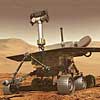
|
 |
Next Boeing Delta 2 rocket launch postponed
Monday's predawn launch of a replacement Global Positioning System satellite aboard a Boeing Delta 2 rocket has been postponed due to technical concerns. A new launch date has not been established.
 MISSION STATUS CENTER MISSION STATUS CENTER
 LAUNCH EVENTS TIMELINE LAUNCH EVENTS TIMELINE
 GROUND TRACK MAP GROUND TRACK MAP
 |  |
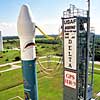
|
 |
OTHER HEADLINES Additional stories today
|
 |
Astronaut Scott Horowitz leaves NASA -- A veteran of four Space Shuttle flights, Astronaut Scott J. "Doc" Horowitz, a retired U.S. Air Force colonel, has left NASA for a position with private industry.

Astronaut Duane Carey leaves space to see the world -- After fulfilling one dream to pilot a Space Shuttle and see the world from space, Astronaut Duane G. "Digger" Carey (Lt. Col, USAF-Ret) has left NASA to pursue another -- to see the planet up close from the open road.

NASA names new chief scientist -- NASA chief scientist and astronaut John Grunsfeld will return to Houston where he is training for an assignment to a long duration mission. Jim Garvin becomes the agency's new chief scientist, effective
immediately.
|
 |
|
Thursday:
October 21, 2004 | |
0001 GMT |
 |
New view of the sky
Astronomers have overcome longstanding technical hurdles to map the sky at little-explored radio frequencies that may provide a tantalizing look deep into the early Universe. The scientists have released images and data covering half of the sky, and hope to complete their survey within a year.
 FULL STORY FULL STORY
 |  |

|
 |
I, Robotic Telescope
The world of astronomy meets the science fiction world of Isaac Asimov's "I, Robot" with the commissioning of a new robotic telescope. While it lacks the humanoid qualities of the movie version, this robot will aid in humanity's quest to understand the early Universe by observing the most distant and powerful explosions known.
 FULL STORY FULL STORY
 |  |

|
 |
Europe's Hipparcos finds rebels with a cause
A team of European astronomers has discovered that many stars in the vicinity of the Sun have unusual motions caused by the spiral arms of our galaxy, the Milky Way. According to this research, based on data from ESA's Hipparcos observatory, our stellar neighborhood is the crossroads of streams of stars coming from several directions.
 FULL STORY FULL STORY
 |  |

|
 |
|
Wednesday:
October 20, 2004 | |
0241 GMT |
 |
Deep Impact prepares for December launch
NASA's Deep Impact spacecraft has arrived in Florida to begin final preparations for a launch on December 30. The probe will fire a copper projectile into the surface of comet Tempel 1 next year to create a crater that could be as large as a football field.
 FULL STORY FULL STORY
 |  |
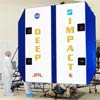
|
 |
Space shuttle movers get new shoes
NASA's two crawler transporter vehicles soon will sport new "shoes." A $10 million project to replace the 456 tread belt shoes, weighing more than one ton each, on both crawlers at Kennedy Space Center begins mid-October.
 FULL STORY FULL STORY
 |  |

|
 |
|
Tuesday:
October 19, 2004 | |
0302 GMT |
 |
Astronomers discover planet building is big mess
Planets are built over a long period of massive collisions between rocky bodies as big as mountain ranges, astronomers announced Monday. New observations from NASA's Spitzer Space Telescope reveal surprisingly large dust clouds around several stars. These clouds most likely flared up when rocky, embryonic planets smashed together.
 FULL STORY FULL STORY
 |  |

|
 |
European probe on track for its Moon encounter
The ion engine of Euoprean Space Agency's SMART-1 probe carried out a continuous thrust maneuver last week in the final major push that will get the spacecraft to the Moon capture point in mid-November.
 FULL STORY FULL STORY
 |  |
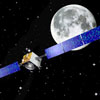
|
 |
OTHER HEADLINES Additional stories today
|
 |
Teams to research critical issues in electric propulsion -- NASA announced the selection of four teams to conduct research into critical issues in electric propulsion in support of the Vision for Space Exploration. Electric-propulsion critical issues research is part of Prometheus, within NASA's Exploration Systems Mission Directorate. Total value of the work over a three-year period is approximately $6 million.
|
 |
|
Monday:
October 18, 2004 | |
0001 GMT |
 |
Cassini yields new knowledge of Saturn's rings
Although Cassini has only been orbiting the planet Saturn since July 1, data from the Cassini Plasma Spectrometer has already begun to provide new information about the curious nature of Saturn's space environment.
 FULL STORY FULL STORY
 |  |
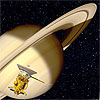
|
 |



